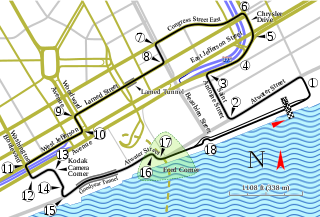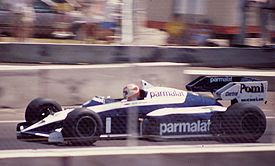Season summary
Although Piquet won twice (in Canada and Detroit), and scored several podium places in the second half of the season, the straight-4cyl BMW engine, or more specifically the turbochargers rather than the engine itself, were now becoming unreliable. The team suffered turbo failures repeatedly in both qualifying and races despite efforts by Gordon Murray and BMW engineers to improve the car and engine, and Piquet did not score his first points of the season until his win in Round 7 in Canada. The John Barnard designed McLaren MP4/2 with its Porsche built TAG V6 turbo was dominant, with drivers Niki Lauda (the 1984 World Champion), and Alain Prost (2nd to Lauda by only ½ a point), winning 12 of the season's 16 races between them, and saw to it that Piquet could not retain his championship. He scored another win at the grueling Detroit Grand Prix a week after his Canadian triumph, but Piquet would not win again that year.
Reliability was found in the second half of the season, which allowed Piquet to eventually finish fifth in the title hunt. The saddest aspect was that the BT53 was, in Piquet and Teo Fabi's hands, regularly faster than the McLarens, as Piquet's nine pole positions throughout the season attested (Prost was the only McLaren driver to qualify on pole during 1984, doing so three times). The car was very quick in qualifying on light fuel loads, but its race pace was negatively affected particularly on full fuel loads. More reliability from the BMW turbo might have given Piquet a realistic chance of defending his championship. Indeed, in the first seven races before scoring his win in Canada, Piquet retired with engine, electrical (as in Monaco) or turbo failure. Often early in the season when he retired, Piquet had either leading the race or was in a position to challenge for the lead.
The BT53 was replaced by the BT54 for 1985.

BMW has been involved in Formula One in a number of capacities since the inauguration of the World Drivers' Championship in 1950. The company entered occasional races in the 1950s and 1960s, before building the BMW M12/13 inline-four turbocharged engine in the 1980s. This engine was the result of a deal between BMW and Brabham, which resulted in the team's chassis being powered by BMW engines from 1982 until 1987, a period in which Nelson Piquet won the 1983 championship driving a Brabham BT52-BMW. BMW also supplied the M12/13 on a customer basis to the ATS, Arrows, Benetton and Ligier teams during this period, with various degrees of success. In 1988, Brabham temporarily withdrew from the sport and BMW withdrew its official backing from the engines, which were still used by the Arrows team under the Megatron badge. Turbocharged engines were banned by the revised Formula One Technical Regulations for 1989, rendering the M12/13 obsolete.

The 1984 Monaco Grand Prix was a Formula One motor race held at Monaco on 3 June 1984. It was race 6 of 16 in the 1984 FIA Formula One World Championship. It was the only race of the 1984 championship that was run in wet weather.

The 1984 Italian Grand Prix was a Formula One motor race held at Monza on 9 September 1984. It was the fourteenth race of the 1984 Formula One World Championship.

The 1986 Austrian Grand Prix was a Formula One motor race held at Österreichring on 17 August 1986. It was the twelfth race of the 1986 Formula One World Championship.

The 1986 Italian Grand Prix was a Formula One motor race held at Monza on 7 September 1986. It was the thirteenth race of the 1986 Formula One World Championship.

The 1987 Belgian Grand Prix was a Formula One motor race held on 17 May 1987 at the Circuit de Spa-Francorchamps, Francorchamps, Wallonia. Contested over 43 laps, the race was the 45th Belgian Grand Prix, the 33rd to be held at Spa and the fourth since the circuit was redeveloped in 1979, and the third race of the 1987 Formula One season.

The 1987 FIA Formula One World Championship was the 41st season of FIA Formula One motor racing. It featured the 1987 Formula One World Championship for Drivers and the 1987 Formula One World Championship for Constructors, which were contested concurrently over a sixteen-race series that commenced on 12 April and ended on 15 November. The World Championship for Drivers was won by Nelson Piquet, and the World Championship for Constructors by Williams-Honda. The season also encompassed the Jim Clark Trophy and the Colin Chapman Trophy, which were respectively contested by drivers and constructors of Formula One cars powered by naturally aspirated engines.

The 1986 FIA Formula One World Championship was the 40th season of FIA Formula One motor racing. It featured the 1986 Formula One World Championship for Drivers and the 1986 Formula One World Championship for Manufacturers, both of which commenced on 23 March and ended on 26 October after sixteen races. The Drivers' Championship was won by Alain Prost, and the Manufacturers' Championship was won by Williams-Honda, thus Honda became the first Japanese engine supplier World Champions of Formula One, and adding a constructors' title to Frank Williams' trophy collection. Prost was the first driver to win back-to-back Drivers' Championships since Jack Brabham in 1959 and 1960.

The 1984 FIA Formula One World Championship was the 38th season of Fédération Internationale de l'Automobile (FIA) Formula One motor racing. Drivers and teams competed in sixteen Grands Prix for the World Drivers' and World Constructors' championship titles. The season ran from 5 March to 21 October.

The 1983 FIA Formula One World Championship was the 37th season of FIA Formula One motor racing. It featured the 1983 Formula One World Championship for Drivers and the 1983 Formula One World Championship for Constructors, which were contested concurrently over a fifteen-race series that commenced on 13 March and ended on 15 October. Nelson Piquet won the Drivers' Championship, his second Formula One title and the first to be won by a driver using a turbocharged engine, while Ferrari won the Constructors' Championship. It was also the last Drivers' Championship won by a Brabham driver.

The 1982 FIA Formula One World Championship was the 36th season of FIA Formula One motor racing. It included two competitions run over the course of the year, the 33rd Formula One World Championship for Drivers and the 25th Formula One World Championship for Constructors. The season featured sixteen rounds between 23 January and 25 September. The Drivers' Championship was won by Keke Rosberg and the Constructors' Championship by Scuderia Ferrari.
Teodorico Fabi is an Italian former racing driver. He competed in Formula One and sports car racing, and claimed pole position in his rookie year at the 1983 Indianapolis 500. Teo is the older brother of former Formula One driver Corrado Fabi.
Piercarlo Ghinzani is a former racing driver from Italy. He currently manages his own racing team, Team Ghinzani, which was created in 1992 and is currently involved in several Formula Three championships.

The 1984 Detroit Grand Prix was a Formula One motor race held on June 24, 1984 in Detroit, Michigan. It was the eighth race of the 1984 Formula One World Championship.

The BMW M12/13 turbo was a 1499.8 cc 4-cylinder turbocharged Formula One engine, based on the standard BMW M10 engine introduced in 1961, powered the F1 cars of Brabham, Arrows and Benetton. Nelson Piquet won the FIA Formula One Drivers' Championship in 1983 driving a Brabham powered by the BMW M12/13 turbo. It was the first Drivers' Championship to be won using a turbocharged engine. The engine also powered the BMW GTP and in the 2.0-litre naturally-aspirated form, the successful March Engineering Formula Two cars. BMW engineers figured the engine produced around 1,400 hp at maximum boost, however the BMW engine dynamometer could not go beyond 1,280 bhp.

The McLaren MP4/2 was a Formula One car produced by McLaren for the 1984 season. An iteration of it, the MP4/2B, was used in the 1985 season, and a slightly updated version, the MP4/2C, raced in the 1986 season for McLaren. It was closely based on the MP4/1E model that was used as a test car, used in the final races of 1983.

The Brabham BT52 was a Formula One car designed for the Brabham team by longtime Brabham designer Gordon Murray for the 1983 season. The car ran on Michelin tyres and was powered by the BMW M12/13 four-cylinder turbocharged engine, which in 1983 produced a maximum power of approximately 1,280 bhp (950 kW) in qualifying trim, detuned to around 850 bhp (630 kW) for the proper races. Its drivers were 1981 World Champion Nelson Piquet and Riccardo Patrese.

The Benetton B186 is a Formula One racing car, built and raced by the Benetton team for the 1986 Formula One World Championship. It was the first car to be constructed and raced by Benetton, which had bought the Toleman team at the end of 1985 after several years of sponsoring it and other teams, including Alfa Romeo and Tyrrell.

The Brabham BT54 was a Formula One racing car designed by Gordon Murray for the Brabham team for the 1985 Formula One season. The car was powered by the BMW M12 4cyl turbo engine and used Pirelli tyres.

The Brabham BT50 was a Formula One racing car designed by Gordon Murray and powered by a turbo BMW engine. It was raced by the Brabham team, owned by Bernie Ecclestone, during the 1982 Formula One season. Driven by Nelson Piquet and Riccardo Patrese, it made its debut at the South African Grand Prix before being withdrawn for further development of its engine while the team reverted to the previous year's car, the Brabham BT49. On the reintroduction of the BT50, Piquet finished fifth in the Belgian Grand Prix. A few races later he drove it to a win in the Canadian Grand Prix. Later in the year it achieved three more finishes in the points for the team. During the second half of the season, Brabham implemented the strategy of mid-race refueling. This allowed Piquet and Patrese to start the races relatively light and use their reduced weight to gain track position over their competitors before stopping to refuel. The poor reliability of the BT50 meant that they had only a few opportunities to demonstrate the strategy in practice.
















